
Volume 15, No 8, Aug 2005
ISSN: 1001-0602
EISSN: 1748-7838 2018
impact factor 17.848*
(Clarivate Analytics, 2019)
Volume 15 Issue 8, August 2005: 576-584
ORIGINAL ARTICLES
Cloning and characterization of a FLORICAULA/LEAFY ortholog, PFL, in polygamous papaya
Qingyi YU1, 2, Paul H.MOORE3, Henrik H. ALBERT3, Adrienne H.K.ROADER4, Ray MING1,*
1Hawaii Agriculture Research Center, Aiea, HI 96701, USA
2Department of Molecular Biosciences and Bioengineering, University of Hawaii, Honolulu, HI 96822, USA
3USDA-ARS, Pacific Basin Agricultural Research Center, Aiea, HI 96701, USA
4Section of Cell and Developmental Biology, University of California, San Diego, La Jolla, CA 92093, USA
Correspondence: Ray Ming(rming@harc-hspa.com)
The homologous genes Floricaula (FLO) in Antirrhinum and LEAFY (LFY) in Arabidopsis are known to regulate the initiation of flowering in these two distantly related plant species. These genes are necessary also for the expression of downstream genes that control floral organ identity. We used Arabidopsis LFY cDNA as a probe to clone and sequence a papaya ortholog of LFY, PFL. It encodes a protein that shares 61% identity with the Arabidopsis LFY gene and 71% identity with the LFY homologs of the two woody tree species: California sycamore (Platanus racemosa) and black cottonwood (Populus trichocarpa). Despite the high sequence similarity within two conserved regions, the N-terminal proline-rich motif in papaya PFL differs from other members in the family. This difference may not affect the gene function of papaya PFL, since an equally divergent but a functional LFY ortholog Needly of Pinus radiata has been reported. Genomic and BAC Southern analyses indicated that there is only one copy of PFL in the papaya genome. In situ hybridization experiments demonstrated that PFL is expressed at a relatively low level in leaf primordia, but it is expressed at a high level in the floral meristem. Quantitative PCR analyses revealed that PFL was expressed in flower buds of all three sex types - male, female, and hermaphrodite with marginal difference between hermaphrodite and unisexual flowers. These data suggest that PFL may play a similar role as LFY in flower development and has limited effect on sex differentiation in papaya.
FULL TEXT | PDF
Browse 2088


